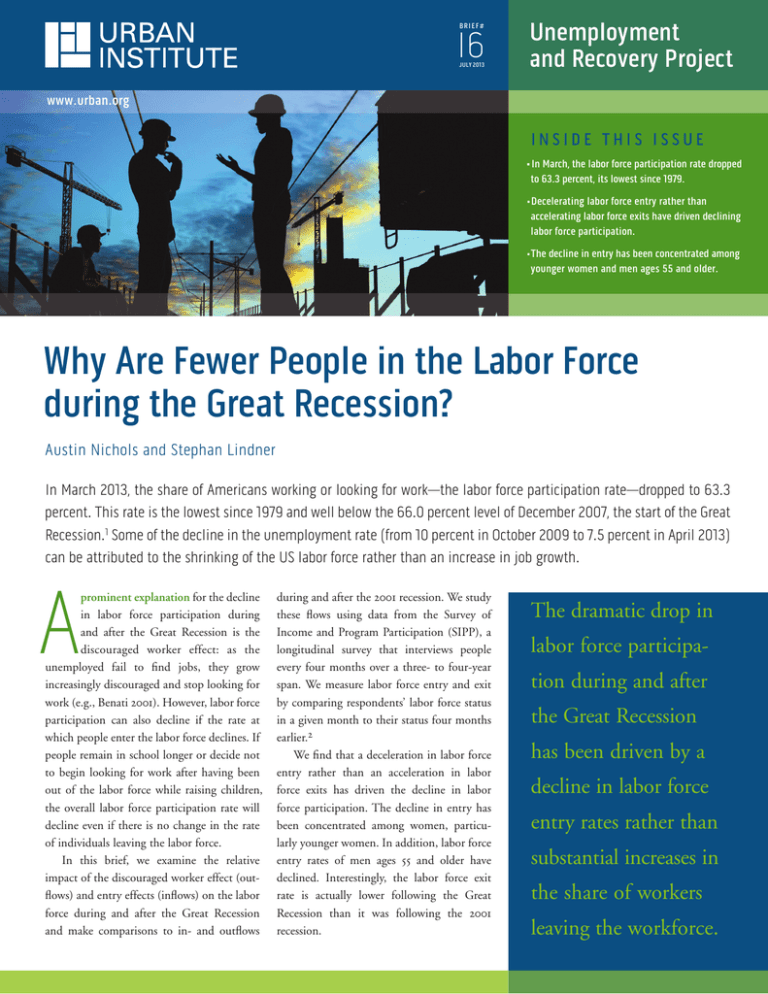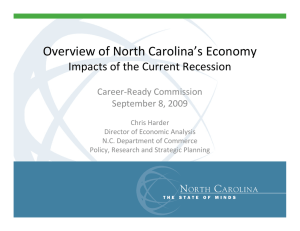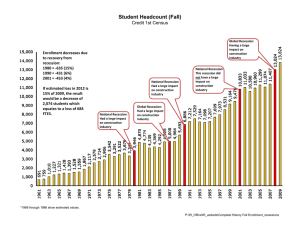I6 Unemployment and recovery Project
advertisement

br i e f# I6 jULY 2013 Unemployment and recovery Project www.urban.org inside This issUe • in March, the labor force participation rate dropped to 63.3 percent, its lowest since 1979. •decelerating labor force entry rather than accelerating labor force exits have driven declining labor force participation. • The decline in entry has been concentrated among younger women and men ages 55 and older. Why Are fewer People in the Labor force during the Great recession? Austin Nichols and Stephan Lindner In March 2013, the share of Americans working or looking for work—the labor force participation rate—dropped to 63.3 percent. This rate is the lowest since 1979 and well below the 66.0 percent level of December 2007, the start of the Great Recession.1 Some of the decline in the unemployment rate (from 10 percent in October 2009 to 7.5 percent in April 2013) can be attributed to the shrinking of the US labor force rather than an increase in job growth. A prominent explanation for the decline in labor force participation during and after the Great Recession is the discouraged worker effect: as the unemployed fail to find jobs, they grow increasingly discouraged and stop looking for work (e.g., Benati 2001). However, labor force participation can also decline if the rate at which people enter the labor force declines. If people remain in school longer or decide not to begin looking for work after having been out of the labor force while raising children, the overall labor force participation rate will decline even if there is no change in the rate of individuals leaving the labor force. In this brief, we examine the relative impact of the discouraged worker effect (outflows) and entry effects (inflows) on the labor force during and after the Great Recession and make comparisons to in- and outflows during and after the 2001 recession. We study these flows using data from the Survey of Income and Program Participation (SIPP), a longitudinal survey that interviews people every four months over a three- to four-year span. We measure labor force entry and exit by comparing respondents’ labor force status in a given month to their status four months earlier.2 We find that a deceleration in labor force entry rather than an acceleration in labor force exits has driven the decline in labor force participation. The decline in entry has been concentrated among women, particularly younger women. In addition, labor force entry rates of men ages 55 and older have declined. Interestingly, the labor force exit rate is actually lower following the Great Recession than it was following the 2001 recession. The dramatic drop in labor force participation during and after the Great Recession has been driven by a decline in labor force entry rates rather than substantial increases in the share of workers leaving the workforce. Why Are fewer People in the Labor force during the Great recession? figure 1. Changes in Labor force Participation by status, 2001 to 2012 Working Unemployed 6 70 66.2 64.9 4.7 66.2 4 65 2.3 60.7 2.1 2 60 0 55 2001 2001 2012 40 6 35 4 3.6 31.9 27.9 29.3 2012 Out of the labor force less than four months Out of the labor force four or more months 30 2.8 29.1 3.1 2.7 2.7 2 0 25 2001 2012 2001 2012 Notes: Official labor force participation rates are based on the Current Population Survey, not the SIPP. The unemployed rate shown here is the share of unemployed relative to all adults, while the official unemployment rate is the share of unemployed relative to all adults in the labor force. 2. Why Are fewer People in the Labor force during the Great recession? The Labor force status, 2001–12 To illustrate the evolution of the labor force in the past decade, figure 1 displays the share of adults belonging to one of the following four categories: (1) working, (2) unemployed, (3) not in the labor force for at least four months, and (4) new labor force leavers (i.e., adults who have left the labor force in the past four months). These categories are mutually exclusive and exhaustive, so their shares add up to 100 percent. The share of employed adults dips slightly from 66.2 percent to below 64.9 percent from 2001 to 2003, recovers until 2006, and then decreases to 60.7 percent in 2012. The share of unemployed adults increases from 2.1 percent in 2007 to 4.7 in 2012, but this increase is smaller than the decline in employment, implying that the share of adults in the labor force declined during the Great Recession.3 New labor force leavers, a group composed, in part, of unemployed workers who became so discouraged that they stopped looking for work, increased slightly from 2007 to 2008 (from 2.5 percent to 3.0 percent), as the Great Recession began.4 This figure remained stable for several years, and even decreased slightly to 2.7 in 2012. Even more surprising, the share of new labor force leavers is slightly lower in 2010 and 2011 (on average 3.0 percent), the years following the Great Recession, than in 2002 and 2003 (on average 3.2 percent), the years following the previous recession. That is contrary to the expectation that more discouraged workers would have left the labor force following the Great Recession than following the 2001 recession. Below, we take a closer look at new labor force leavers and entrants by comparing 2002 and 2003 figures against 2010 and 2011 figures.5 new Labor force Leavers and entrants Labor force entry and exit patterns by age and gender differed notably between the years following the Great Recession and those Table 1. recent Labor force exit rates by Age, 2002–03 and 2010–11 Men WoMen 2002–03 2010 –11 2002–03 2010 –11 All 3.0 2.8 3.4 3.1 18–22 8.0 8.1 8.7 7.7 23–29 3.8 4.0 5.2 4.7 30–54 2.2 1.8 3.1 2.8 55–61 2.8 2.5 3.0 2.5 62–66 3.8 3.3 3.0 2.9 67+ 1.5 1.5 0.9 1.0 Source: US Census Bureau, Survey of Income and Program Participation, 2001–12. Note: This table shows the percentage of people not in the labor force who had been in the labor force four months earlier, averaged over the two-year spans. following the 2001 recession. We report entry and exit rates for men and women by age using six age categories.6 The first two age groups (ages 18 to 22 and ages 23 to 29) encompass people who might still be completing their schooling and, therefore, may not be in the labor force. The third age group (ages 30 to 54) includes adults with high labor force attachment. In the fourth and fifth age groups (ages 55 to 61 and ages 62 to 66), labor force participation is in decline as people approach retirement. The last group (ages 67 and older) includes people who work beyond full retirement age. Table 1 displays the percentage of men and women leaving the labor force by age. Overall, men are slightly less likely to exit the labor force in the years following the Great Recession than in the years following the 2001 recession, but that masks important differences by age. The share of younger men (ages 18 to 29) is slightly higher in 2010 and 2011 than in 2002 and 2003, while the share of older men (ages 30 and older) leaving the labor force is slightly lower. Younger workers leaving the labor force are far more likely to be returning to school than are older labor force leavers. Those who are enrolled in school are likely to return to the labor force with new and better skills. Of course, some of the young labor force leavers may simply have retreated to their parents’ couches and basements, and even though they may well return to the labor market in the future, their longterm economic prospects have been diminished (Kahn 2010). For women, the share of new labor force leavers is lower for all age groups in 2010 and 2011 than in 2002 and 2003, and the overall decline is also more pronounced compared to that for men. Table 2 shows the percentage of men and women entering the labor force by age. Both genders experience a slight decline in the share of new labor force entrants from 2002 and 2003 to 2010 and 2011. However, this decline in labor force entry rates is the driving force behind the decline in labor force participation. Entry rates for women are lower for all age groups in 2010 to 2011 than in 2002 to 2003. Among men, however, the 3. Why Are fewer People in the Labor force during the Great recession? Table 2. Labor force entry rates by Age, 2002–03 and 2010–11 Men WoMen 2002–03 2010 –11 2002–03 2010 –11 All 2.8 2.7 3.3 3.0 18–22 10.1 10.2 10.3 9.6 23–29 3.9 4.3 5.2 4.8 30–54 1.9 1.8 3.0 2.7 55–61 2.0 1.7 2.1 1.7 62–66 2.0 1.3 1.8 1.5 67+ 1.0 0.9 0.6 0.6 Source: US Census Bureau, Survey of Income and Program Participation, 2001–12. Note: This table shows the percentage of people not in the labor force who had been in the labor force four months earlier, averaged over the two-year spans. decline is concentrated among those ages 30 and older, particularly among those ages 62 to 66. The difference in the change in labor force entry between younger men and women may indicate that younger women, seeing poor labor market prospects, choose to obtain more education or start families, while younger men continue to try to start or restart their working lives. When individuals decide to enter the labor force, they can do so either by taking jobs or by becoming job seekers; if they become job seekers, then they are considered unemployed. Not surprisingly, the share of new labor force entrants coming into the labor market as unemployed job seekers is higher, and the share entering with new jobs is lower, in the years following the Great Recession than in the years following the 2001 recession. Conclusion The dramatic drop in labor force participation during and after the Great Recession has been driven by a decline in labor force entry rates rather than substantial increases in the share of workers becoming discouraged and leaving the workforce. Although labor force exits following the Great Recession are on par with the 2001 recession, the decline in labor force entry rates suggests that when a worker leaves the labor force today, they are less likely to try to reenter than in the past. In addition, younger women have become less likely to enter the labor force than they were a decade ago. The fact that labor force exits are not higher during and after the Great Recession than during and after the 2001 recession is surprising, especially given the decline in labor force entry. The latter finding is plausible: because of lackluster growth in aggregate demand for goods and services, the labor market has not recovered quickly from the Great Recession (Elsby et al. 2011). However, fewer job opportunities would typically be expected to produce more discouraged workers, with greater rates of exit from the labor force. Two possible explanations for this conundrum could be changes in the composition of the labor force during the Great Recession and the impact of extensions to unemployment insurance. During the Great Recession, people with a high labor force attachment lost their jobs. Because these people are less likely to give up searching for jobs, that potential change in the composition of the unemployed could explain why labor force exit rates have been lower than expected. Also, in 2008, Congress enacted the Emergency Unemployment Compensation program. This program and subsequent extensions to it increased the potential duration of benefits from 26 to up to 99 weeks. Although some unemployment insurance extensions were enacted during the 2001 recession, they did not come close to reaching the magnitude of those enacted during the Great Recession. These extensions have kept some unemployed workers from dropping out of the labor force (Rothstein 2011), contributing to the lower share of labor force leavers in 2010 and 2011 as compared with 2002 and 2003. Although such compositional or policy changes have kept people in the unemployed pool, the weak labor market prevents many people from finding new employment. However, because they are remaining in the labor market, they may be more likely to seize job opportunities as the economy continues to recover than if they had left the labor market. In addition, younger women who delayed entering or reentering the labor market in recent years may be better positioned to take advantage of a growing economy if they spent their time out of the labor market acquiring new skills. The reluctance of older workers to reenter the labor market in recent years, however, is troubling, as they may be increasingly likely to remain permanently out of the workforce, potentially compromising their retirement security (Flinn and Heckman 1983; Jones and Riddell 1999). • 4. Why Are fewer People in the Labor force during the Great recession? notes references 1. See labor force statistics from the Current Population Survey, 2003–12, http://data.bls.gov/timeseries/LNS14000000. Benati, Luca. 2001. “Some Empirical Evidence on the ‘Discouraged Worker’ Effect.” Economics Letters 70(3): 387–95. 2. We use four months for the comparison because the SIPP surveys respondents every four months (known as waves), and monthly changes within a wave tend to be underreported (Marquis and Moore 1989). Elsby, Michael W. L., Bart Hobijn, AyŞegül Şahin, and Robert G. Valletta. 2011. “The Labor Market in the Great Recession—An Update to September 2011.” Brookings Papers on Economic Activity 43(2): 353–84. 3. The share of unemployed adults is lower than the unemployment rate because the latter is measured as the number of people unemployed divided by the number of people in the labor force. Flinn, Christopher J., and James J. Heckman. 1983. “Are Unemployment and Out of the Labor Force Behaviorally Distinct Labor Force States?” Journal of Labor Economics 1(1): 28–42. 4. The group also includes individuals who left the labor force to enroll in school, retire, or attend to family matters, such as raising children or taking care of other family members. 5. The end of a recession and the beginning of the recovery is the time when GDP reaches its lowest level. For the 2001 recession, GDP was lowest in November 2001, and for the Great Recession, GDP was lowest in June 2009 (see http://www.nber.org/cycles.html). 6. We calculate shares for age groups by dividing the number of (female or male) labor force leavers or entrants in an age group by the number of (female or male) adults in that age group. Jones, Stephen R. G., and W. Craig Riddell. 1999. “The Measurement of Unemployment: An Empirical Approach.” Econometrica 67(1): 147–62. Kahn, Lisa. 2010. “The Long-Term Labor Market Consequences of Graduating from College in a Bad Economy.” Labour Economics 17(2): 303–16. Marquis, Kent H., and Jeffrey C. Moore. 1989. “Some Response Errors in SIPP—with Thoughts about Their Effects and Remedies.” Proceedings of the Section on Survey Research Methods, American Statistical Association. http://www.amstat.org/sections/srms/Proceedings/papers/1989_067.pdf. Rothstein, Jesse. 2011. “Unemployment Insurance and Job Search in the Great Recession.” Brookings Papers on Economic Activity 43(2):143–96. 5. Why Are fewer People in the Labor force during the Great recession? About the Authors Unemployment and recovery Project Austin Nichols is a senior research associate in the Urban Institute’s Income and Benefits Policy Center and an affiliate of the Urban-Brookings Tax Policy Center. This brief is part of the Unemployment and Recovery project, an Urban Institute initiative to assess unemployment’s effect on individuals, families, and communities; gauge government policies’ effectiveness; and recommend policy changes to boost job creation, improve workers’ job prospects, and support out-of-work Americans. Major funding for the project comes from the Rockefeller and Ford Foundations. Copyright © July 2013 Stephan Lindner is a research associate with the Income and Benefits Policy Center at the Urban Institute. The views expressed are those of the authors and do not necessarily reflect those of the Urban Institute, its trustees, or its funders. Permission is granted for reproduction of this document, with attribution to the Urban Institute. UrbAn insTiTUTe 2100 M street, nW ● Washington, dC 20037-1231 (202) 833-7200 ● publicaffairs@urban.org ● www.urban.org 6.






